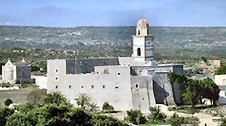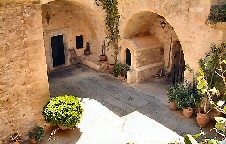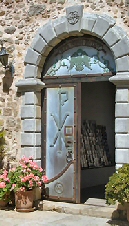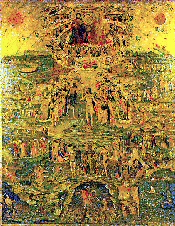Moni Toplou, a Monastery with a Gun
Moni Toplou, a Monastery with a Gun
The eastern part of Sitia in Crete is almost a deserted place, but the coastal road going off east of the town is the only one in the area with traffic because it leads to the two popular sights in east Crete - the Toplou Monastery or Moni Toplou and the palm tree forest at Vai which we will be talking on another article. On the coastal road there is not much to see, until you arrive at the historic Toplou Monastery. Be careful as the road is narrow and has many badly-designed bends.
 The Monastery stands alone in the middle of
no-where. It has been built in mid 15th century at a time when
pirates and bandits of all nationalities were ravaging Crete and
has withstood many attacks and occupations by invading forces. This
is partly due to its strategic position. So the monks built a thick
and strong 10 m high wall around the monastery complex. The wall
has small windows like arrow-holes, a heavy castle gate, and murder
holes for pouring out boiling oil onto the heads of attackers.
There is also a cannon on the rampart of the door. The Turkish word
for a cannon is top, hence the name of the monastery is “Moni
Toplou” or “Monastery with a Gun.”
The Monastery stands alone in the middle of
no-where. It has been built in mid 15th century at a time when
pirates and bandits of all nationalities were ravaging Crete and
has withstood many attacks and occupations by invading forces. This
is partly due to its strategic position. So the monks built a thick
and strong 10 m high wall around the monastery complex. The wall
has small windows like arrow-holes, a heavy castle gate, and murder
holes for pouring out boiling oil onto the heads of attackers.
There is also a cannon on the rampart of the door. The Turkish word
for a cannon is top, hence the name of the monastery is “Moni
Toplou” or “Monastery with a Gun.”
 The main building of 800 m² has three floors, divided into
cells, for guests, kitchens, the abbot’s residence and many
warehouses. The bell tower has relief crowns and crosses with
inscriptions dating back to 1558. The 13th Ephorate of Byzantine
Antiquities carried out works of consolidation and restoration. In
the Monastery, there is also an interesting Museum.
The main building of 800 m² has three floors, divided into
cells, for guests, kitchens, the abbot’s residence and many
warehouses. The bell tower has relief crowns and crosses with
inscriptions dating back to 1558. The 13th Ephorate of Byzantine
Antiquities carried out works of consolidation and restoration. In
the Monastery, there is also an interesting Museum.
 Despite the strong fortification, the monastery was destroyed
twice in his history, once by the Knights of Malta in 1530 and
later by the Turks in 1646. Its high walls have been a refuge for
rebels, both under the Turkish rule and during the German
occupation in World War II. There is a cave nearby the monastery
that has been used as a wireless station for the resistance against
the Germans. There is a steep dirt road leading to the cave about
500 meters away from the monastery towards Sitia. Most
of the monastery’s heirlooms were
destroyed by the Turks in 1646, but still it is one of the best
preserved and richest monasteries of Crete and there are plenty of
things to see in the church and museum rooms surrounding the inner
courtyard between the high walls.
Despite the strong fortification, the monastery was destroyed
twice in his history, once by the Knights of Malta in 1530 and
later by the Turks in 1646. Its high walls have been a refuge for
rebels, both under the Turkish rule and during the German
occupation in World War II. There is a cave nearby the monastery
that has been used as a wireless station for the resistance against
the Germans. There is a steep dirt road leading to the cave about
500 meters away from the monastery towards Sitia. Most
of the monastery’s heirlooms were
destroyed by the Turks in 1646, but still it is one of the best
preserved and richest monasteries of Crete and there are plenty of
things to see in the church and museum rooms surrounding the inner
courtyard between the high walls.
 The monastery in general is dedicated to Panagia
Theotokos and its small chapel is dedicated to the Birth of the
Virgin Mary. This chapel or katholicon is a two-aisled church,
the northern one dedicated to the Virgin, and
the southern posterior one to St John the Theologian.
It contains a wonderful icon known as “Great Art Thou, O Lord” that
depicts sixty-one scenes from the Orthodox liturgy. This icon is
the work of the famous icon painter Ioannis Kornaros and dates back
to 1770. Another important thing to see is an epigraph of the 2nd
century BC, engraved on a stone plaque, which comes from ancient
Itanos and contains the first 80 lines of the Treaty of Magnisia
signed by the Cretan cities of Itanos and Ierapytna under the
arbitration of the Asia Minor city of Magnisia. This stone was
functioning as the altar in the chapel of the
monastery’s cemetery, but now it has been
enshrined in the external wall of the chapel. Many other very
interesting Byzantine icons, handwritten bibles, vestments,
manuscripts and many other ecclesiastical artifacts are being
displayed in the monastery museum rooms. There are also well
preserved wall paintings going back to the 14th
century. Today there are very few monks in
the monmastery, but the monastery still owns a huge part of the land
which is cultivated and brings earnings for the monastery.
The monastery in general is dedicated to Panagia
Theotokos and its small chapel is dedicated to the Birth of the
Virgin Mary. This chapel or katholicon is a two-aisled church,
the northern one dedicated to the Virgin, and
the southern posterior one to St John the Theologian.
It contains a wonderful icon known as “Great Art Thou, O Lord” that
depicts sixty-one scenes from the Orthodox liturgy. This icon is
the work of the famous icon painter Ioannis Kornaros and dates back
to 1770. Another important thing to see is an epigraph of the 2nd
century BC, engraved on a stone plaque, which comes from ancient
Itanos and contains the first 80 lines of the Treaty of Magnisia
signed by the Cretan cities of Itanos and Ierapytna under the
arbitration of the Asia Minor city of Magnisia. This stone was
functioning as the altar in the chapel of the
monastery’s cemetery, but now it has been
enshrined in the external wall of the chapel. Many other very
interesting Byzantine icons, handwritten bibles, vestments,
manuscripts and many other ecclesiastical artifacts are being
displayed in the monastery museum rooms. There are also well
preserved wall paintings going back to the 14th
century. Today there are very few monks in
the monmastery, but the monastery still owns a huge part of the land
which is cultivated and brings earnings for the monastery.
Some final reminder for visiting monasteries in Greece is the existence of etiquettes regarding the way you are dressed. In most monasteries no shorts are allowed, either for men and women, as well as swimming suits or “hot” mini skirts. If they think that you are not dressed decently, they will not allow you to enter the monastery, so be prepared for this. However in many monasteries there are simple clothes you can wear and visit the inside. Also in many monasteries with important icons and wall paintings taking photographs is not allowed.
February 23, 2009
